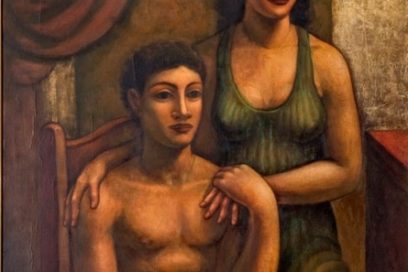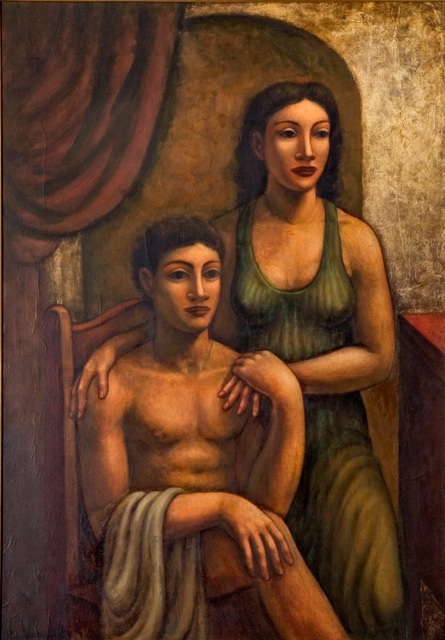
There are three significant pictures from the brilliant Cuban-Chilean painter Mario Carreño (Havana 1913- Santiago de Chile, 1999), done in the second half of the 1930s that discern like irrefutable marks of a period characterized by great events in the life of the maestro, which undoubtedly reflect his personality.
Before referring to his works titled Pareja (oil painting in canvas, 143 x 100.5 cm), Estudio or Desnudo, 1937 (oil painting in canvas, 158 x 119 cm), and Cabeza de mujer, ca. 1937 (lacquer on wood 61 x 48.5 cm), I think it is worth talk about the closest antecedents of his job, when the artist was still young – about 24 or 25 years old- and his creations were starting calling the attention of critics, collectors and lovers of arts.
When he was just 19, Carreño decided to migrate to Spain. In his first stay there he matured as painter, showing amazing artistic and human sensitivity. There he studied at the famous Fine Arts Real Academy of San Fernando founded in 1752 –it is today the second gallery of Spain – at the same time he managed to vanguard art circles and had very closed friendship with several famous personalities from art and culture such as Federico Garcia Lorca, Rafael Alberti, Miguel Prieto, Acario Cotapos, Manuel Altolaguirre, Ramon Gomez de la Serna and also the Chilean Pablo Neruda with whom he consolidated his fraternity that was cut with his death in 1973.
The unfavorable economic and social circumstances he had after the beginning of the Spanish Civil War created in him a mood similar to the one he experience in Cuba when he decided to leave: wars, murders and terror imposed on the streets by the government of Gerardo Machado and Morales (Camajuani, 1871-Miami Beach, 1939). So, he returned to Cuba by the end of 1936 and at the beginning of 1937, he traveled to Mexico, a country he felt devotion for after knowing about it in Europe from famous muralists living there who somehow had revolutionized Latin American painting.
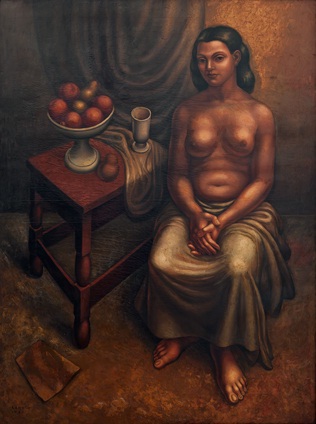
He was moved when he knew about that movement of deep social impact that not only made his spirit shudder, but also made wider and deeper his understanding and link to art, thanks to his rapport with the works from Diego Rivera, Rufino Tamayo, Jose Clemente Orozco, David Alfaro Siqueiros and Frida Kahlo that he personally knew.
However, in his artistic formation there is no doubt he received better benefits in his training with the renowned Dominican painter Jaime Colson (Puerto Plata, Dominican Republic, 1901-Santo Domingo, 1975), whom he met in 1936 and was the one who informed him on the most influential artistic trends in that period. Likewise, the maestro’s style will definitively influence in the course painting will take from the Cuban craftsman in whose production starts to show a greater interest for classicism.
Somehow, either by one or another influence, Carreño faces another way to see art, which encourages him rethink the sense of his painting, above all the one that had to be with the roots of the Latin American culture, and mainly with the one of his Island (Cuba) and the Caribbean whose influence accompanied him the rest of his outstanding artistic career.
According to critics and studious people of his iconographic work one of his most relevant jobs is in Estudio o Desnudo, 1937, which is the objective of this article, where you can distinguish, like in the ones mentioned before, the greatness of the Mexican painting and the fascination of the classic forms captured from Colson. “With this monumental Desnudo, Carreño adds, making ostentation of a technical master that always accompanied him, to the main trend of the Cuban painting, where there are already pioneers and youngsters followers”, said Ramon Vazquez Diaz, specialist of vanguard art.
It is worth remember that after his return from Mexico and also in 1937, Careño was granted the Honor Award of the Official Hall from Havana, a year when he painted Mujer sentada con frutas and probably Cabeza de mujer, two oils where you can see a greater job in the muscles, and also a splendid accuracy and beauty in the integral treatment of the human figures, which he describes by an admirable anatomic draw.
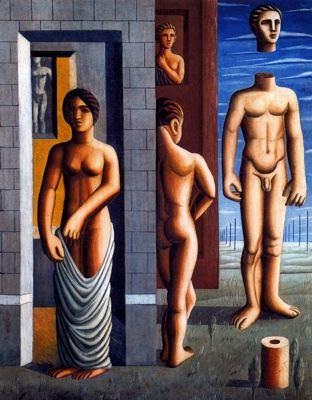
In the way to represent physiognomy and muscles of his characters there is lot of Jaime Colson’s influence. In the classic, volume and immutability concept of his nudes and figures can be established certain relation with some Colson’s most important works by that time, such as those titled Maternidad and Dos Mujeres Vestidas, both from 1937 where you can see a careful study of the nude, on which there is the force majeure of expressivity in these paintings, an intention that evidently was transmitted by the Dominican maestro to the young painter.
There is then in Carreño a symbiosis of different influences: in one side there is Mexican mural painting with his exuberant figures of farmers, workers and people from the city, in social topics that notably impressed him and motivated him to start in Latin American neoclassicism; the interest by Greco-Latin classic forms from Jaime Colson, who turns into the catalytic element of the painter; and the knowledge acquired in Europe as painter, learning where he was also motivated by the Italian paintings of the Renaissance.
Like in the worked above mentioned between 1936 and 1937, “the painter met with playful topics from the tropic: the pulpy fruit, the body with skin that absorb the light as a pretty curious prism, the repeated forms, full, chubby, twisted, and sowed with smiling dimples. An unexpected meeting and very well saved by Carreño, this find under the undulatory movement of sensuality of the mixed race, the fine profile of the Milo Venus”, as the famous critic Guy Perez-Cisneros said.
Either in Estudio or Desnudo, or in Pareja, as well as in other works in this period, like El Manto de Demeter (1938) and Músicos en interior (Musicians inside) from 1938, we can appreciate that recurrent interest of the painter in different issues related to men and the world surrounding him: love, maternity, solitude…will be some of the topics he will recreate in his paintings, where the characters are used to be naked or semi-naked, where he tries to reveal the intimist aspect, pure and more transparent of his fellow men, in which corporal solidity also falls, in a great extent, of the humoristic message of their speeches, as it can be seen in two of his works of the above mentioned jobs.
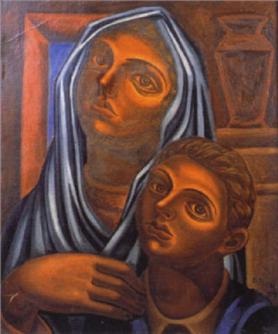
The well-known critic Rafael Marquina said several years after in Revista Cubana, Vol. XXXI-2, from the April-June 1957 that the reason why he painted Mario Carreño was for his “worries for the human being. With his presence or not; in a figure or in apparent concealment; man is his world searching for a world for man. Without this cardinal worry, without this no ostentatious but evident presence the current painting – master and solid- from Mario Carreño would have been an adventure with no plan, no feat, no sense. But, due to the man’s presence in explosion and peace of his anxieties, this painting from Mario Carreño is a marvelous, wonderful and super plentiful and triumphal heroic deed”.
It is possible that some of these paintings, object of these lines have been part of the historical exhibition Carreño carried out on April 1939 at Bernheim-Jeune Gallery in Paris, an exposition visited by important figures from art, among them Pablo Picasso, where it was also exhibited works from Jaime Colson and the Costa Rican Max Jimenez.
At Luz City the already well-known Cuban painter approached more to cubism and surrealism, as well as abstraction and in general to all vanguard movements by then. He registered at the Julien Academy and at the Ecole des Arts appliqués where he learned about the fresco technique. In France he had a strong friendship with Oscar Dominguez, a surrealist painter and Onorio Condoy, an sculptor introduced by Pablo Picasso, whom he had significant links of friendship.
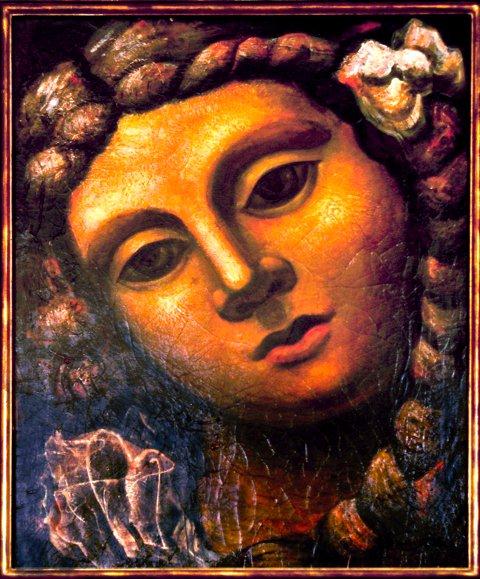
In 1941 Carreño returned to Cuba after several years in Europe and the United States. He kept on isolating from the classic to make incursions more in the sea or country views, while he extended his look to “reminiscences” of the popular painting. This way he travels from the Greco-Latin neoclassicism to a more expressionist vision of the baroque. This way he got into his more personal and intimate period with the characteristic of using from his individual knowledge, to all he had made his experience as artist rich that had precisely started with his first trip to Mexico and his first contacts with Jaime Colson.
In the history of the Latin American art there are his pieces Estudio o Desnudo, Pareja and Cabeza de Mujer, as his proud Greco-Latin characteristics and their juicy musculatures. A period crowned with the most emblematic of all his works, El Nacimiento de las Naciones Americanas (1940), with muralist inspiration has been left behind, which the author himself qualified as his “thesis” painting.

